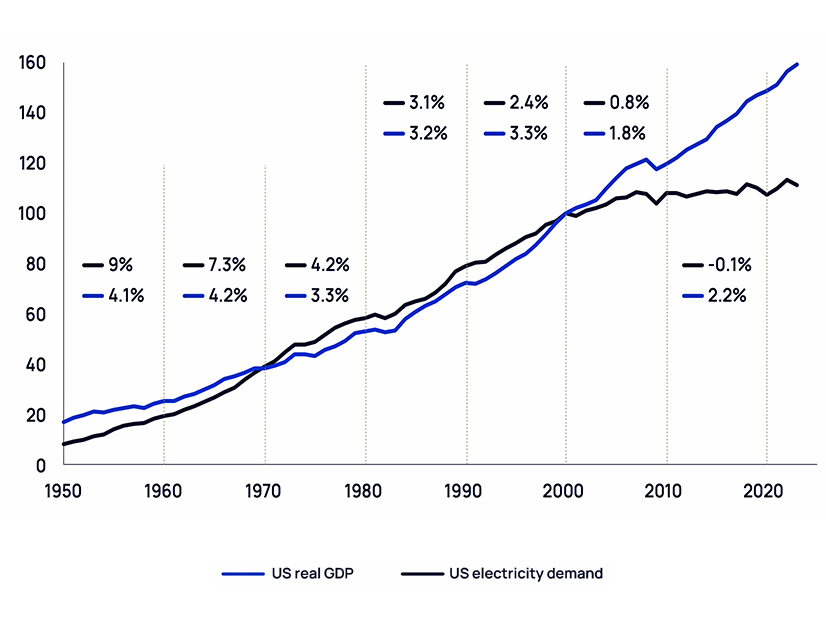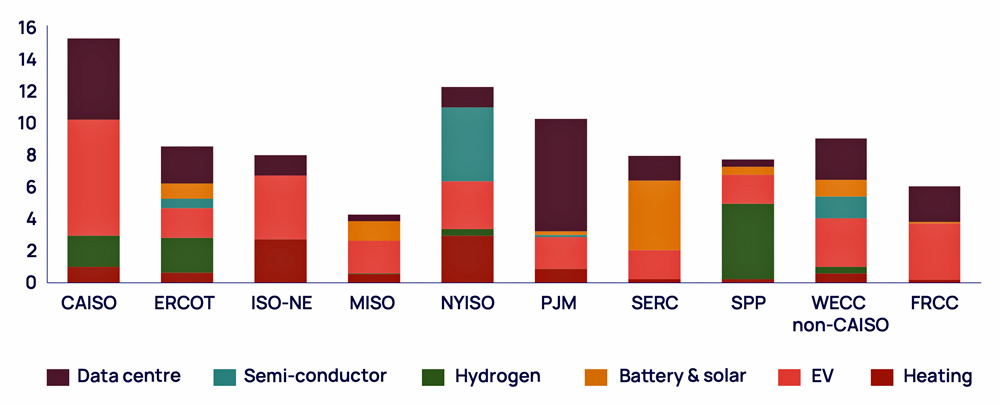
U.S. electric utilities have been caught “flat-footed” by the impending demand for electricity, Wood Mackenzie asserts in a new report.
Growth of the U.S. economy has far outpaced growth in the amount of power needed to run the economy so far this century, but that trend is set to reverse, the analytics firm said in the October edition of its Horizons report.
The expected growth of new electric-intensive technology in data centers, vehicles and industry sets the stage for constraints as the “move fast and break things” ethos of Big Tech bumps up against the five- to 10-year window in which generation and transmission projects are planned and executed.
The utilities and developers that can adapt most quickly will reap rewards, according to “Gridlock: the demand dilemma facing the US power industry.”
It adds that an era of upward pressure on wholesale power prices likely is at hand.
Author Chris Seiple, Wood Mackenzie’s vice chairman of power and renewables, said in a news release that there will be a period of adjustment.
“Most state public utility commissioners have little experience … regulating in a growth environment,” he said. “And as technology C-suites realize that energy may be the largest constraint on their growth, they are shocked as businesses that move at light speed learn about the pace at which electric utilities move.”
Growth of U.S. GDP and U.S. electrical demand roughly tracked one another from the 1950s to the 1990s, and then electric demand tapered off, the report notes. In the 2010s, it said, electric demand was flat while the economy grew 24%.
That is changing in the 2020s.
The report forecasts demand growth of 4 to 15% through 2029, depending on region, with some utilities seeing a much greater increase. It suggests an integrated response from utilities, regulators and policymakers to meet this challenge.
The last time the U.S. electrical industry saw such unexpected demand growth was during World War II, Seiple said. Manufacturing output tripled from 1939 to 1944, and electricity demand rose 60%.
“It was a closely coordinated national effort that brought together industry and policymakers to address the challenge and find innovation along the way,” he said. “A similar effort is needed now.”
Wood Mackenzie identified data centers and artificial intelligence as a main driver of the increased demand — it said new data center announcements since January 2023 total 51 GW of new capacity.
Not all will be built, the report notes, but neither is the list complete or comprehensive — there probably are more proposals that Wood Mackenzie did not identify. Oncor alone recently reported 59 GW of data center connection requests.
The report bases its projections for future data center demand on 15% annual growth from 2025 to 2029, a midrange scenario.
Meanwhile, a resurgent U.S. manufacturing sector, particularly for products such as batteries, solar wafers and computer chips, could add as much as 15 GW of high-load-factor demand. Electrolyzers for hydrogen production and chargers for EVs could add 7 GW.
Against this backdrop, coal-burning plants are scheduled to retire in significant number, transformers and breakers are in short supply, and the interconnection process for new generation is sluggish.
This last factor — transmission planning, permitting and construction — is the biggest bottleneck, the report said.
Seiple said an interesting dynamic to watch would be the number of coal plant retirements deferred and shuttered nuclear plants proposed for reopening in markets where there is no retail choice, compared to the number in markets where there is choice. More natural gas-fired generation is likely to be proposed, as well.
The report cautions that projections of future growth in electric demand are fraught with uncertainty — it may not materialize as forecast if utilities cannot respond quickly enough.
Secondary factors further muddy the picture:
Many of the new factories being proposed would rely on government policies and/or subsidies that could change or be canceled.
Developers of data centers want 24-7 clean energy at a steady rate to boost their environmental credibility, but most clean energy coming online today is intermittent. Nuclear fission may provide a solution, but not until the 2030s at the earliest.
Emissions-free generation often is sited far from these new centers of demand, creating a need for new transmission and adding another layer of cost and complication.
The report notes that developers, regulators and utilities have been looking for innovative solutions — or in some cases, an end run around each other, such as behind-the-meter generation co-located with demand.
The report offers a suggestion to the electric utility sector:
“Over the past 30 years, the industry has evolved the process of large-generation interconnection. It now needs to do the same for large loads to protect the financial interests of utility shareholders and ratepayers, to provide a transparent, non-discriminatory process for large loads competing for access to energy and to provide transparency to market participants on possible demand growth.”




